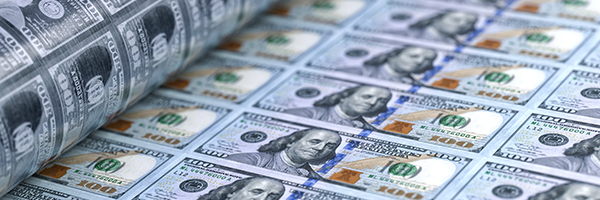
January 4, 2023 | Daily JAM |
Late in December, the Bank of Japan announced, unexpectedly, that it was adjusting its policy for buying bonds. Even something as vague as that is enough to rattle financial markets because Japan is the world’s largest creditor. At the end of 2021, it held roughly $3.2 trillion in foreign assets, 30? more than No. 2 Germany. As of October, it owned over a trillion dollars of U.S. government debt, more than China. Japanese banks are the world’s largest cross-border lenders, with nearly $4.8 trillion in claims in other countries. The policy change was relatively minor–a decision to raise the ceiling on yields for the 10-year bond. But global bond markets have been waiting for any signs that say the days of 0% (or lower) bond yields in Japan might be coming to an end.

July 17, 2022 | Daily JAM, Friday Trick or Trend |
The dollar is likely to get another boost from the Bank of Japan and the European Central Bank this week. On Thursday, the European Central Bank is likely to report its first interest-rate increase in more than a decade. But the increase is likely to be just 25 basis points. That will be a stark reminder of how far behind the Federal Reserve, which raised interest rates 75 basis points in June and is expected to increase rates by another 75 basis points at its July 27 meeting. On Thursday the Bank of Japan is expected to keep its benchmark interest rates at its current low, low, low level.

June 12, 2018 | Daily JAM, Morning Briefing, Short Term |
The summit between U.S. President Donald Trump and North Korean dictator Kim Jong Un produced nothing of import, apparently meeting financial market expectations for "much ado about nothing," and all eyes on Wall Street have shifted to what I'm calling Central Bank...

December 11, 2017 | Daily JAM, Mid Term |
Both Citigroup and JPMorgan Chase are now predicting that average interest rates across the world’s advanced economies will climb to at least 1% in 2018. That might not seem like much, but remember that major economies such as Japan and the European Union now have negative interest rates. Overall the two Wall Street megabanks are telling investors to get ready for the biggest tightening of monetary policy since 2006, before the global financial crisis.

July 9, 2017 | Daily JAM |
To subscribe to JAM you need to fill in some details below including, ahem, some info on how you'll pay us. A subscription is $199 (although if you're subscribing with one of our special offers it will be lower) for a year for ongoing and continuing access to the...
March 16, 2017 | Uncategorized |
To subscribe to JAM you need to fill in some details below including, ahem, some info on how you'll pay us. A subscription is $199 (although if you're subscribing with one of our special offers it will be lower) for a year for ongoing and continuing access to the...
February 1, 2017 | Daily JAM, Morning Briefing |
Data released yesterday on growth in the EuroZone and Japan–coming after disappointing U.S. growth reported last week–certainly raise the question of whether the United States is quite as far ahead of the rest of the world’s developed economies as current market thinking believes
December 28, 2016 | Daily JAM, Mid Term |
To subscribe to JAM you need to fill in some details below including, ahem, some info on how you'll pay us. A subscription is $199 (although if you're subscribing with one of our special offers it will be lower) for a year for ongoing and continuing access to the...
September 21, 2016 | Daily JAM, Morning Briefing |
The Bank of Japan threw the country’s financial sector a bone today–not much more than that certainly. At its regular monetary policy meeting the Japanese central bank said it would keep its short-term policy rate at a negative 0.1% while working to keep the yield on the 10-year government bond near 0%
September 17, 2016 | Short Term, Volatility |
To subscribe to JAM you need to fill in some details below including, ahem, some info on how you'll pay us. A subscription is $199 (although if you're subscribing with one of our special offers it will be lower) for a year for ongoing and continuing access to the...
September 16, 2016 | Daily JAM, Morning Briefing |
Next week it’s actually the Bank of Japan meeting rather than the Federal Reserve’s that has the most power to move financial markets in the short run. Partly that’s because the Federal Reserve’s isn’t likely to do anything at its September 21 meeting. But partly its because there is real uncertainty about what the Bank of Japan might do at its September 21 meeting. The worry is that the bank will decide to cut back on purchases of long-term bonds and at the same time reduce short-term interest rates further

September 11, 2016 | Daily JAM, Volatility |
To subscribe to JAM you need to fill in some details below including, ahem, some info on how you'll pay us. A subscription is $199 (although if you're subscribing with one of our special offers it will be lower) for a year for ongoing and continuing access to the...








